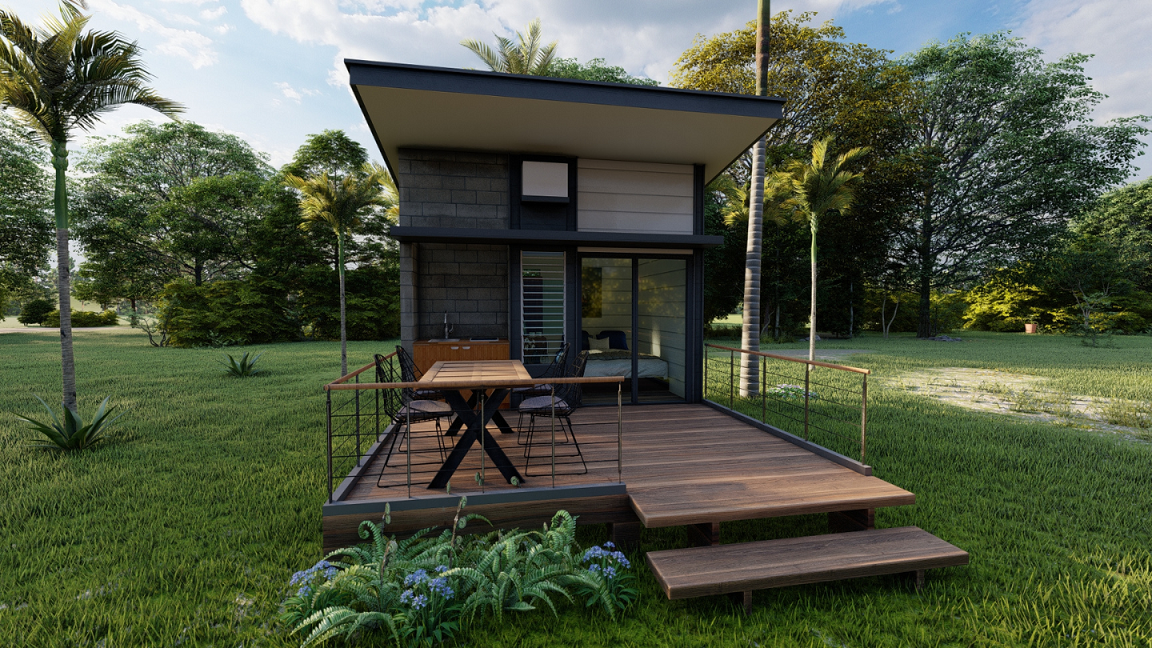
The exterior design is just as important as the interior in tiny homes as it sets the tone, creates curb appeal, and showcases your personal style. In this blog post, we’ll explore tips and ideas to help you elevate the exterior design of your tiny home, from clever fixtures to creative design elements.
Metal, Vinyl, or Wood – What type of siding is best?
When it comes to selecting the exterior siding for your tiny home, making the right choice is essential to bring your vision to life and enhance the overall aesthetic. Whether you’re constructing a permanent tiny home or embarking on an adventure with a mobile one, the siding you choose plays a significant role in defining the character and style of your home.
Wood Siding
One popular option for tiny homes is wood siding, which offers a natural and charming look, particularly well-suited for craftsman-style tiny homes. You can achieve a timeless and inviting exterior With cedar wood, white cedar, red cedar, or Douglas fir. It’s important to consider potential drawbacks, such as the risk of bug damage and pest infestation, which require diligent maintenance and preventive measures.
Metal Siding
Metal siding is an excellent choice for those seeking durability and minimal maintenance. It is less likely to face infestations or bug damage compared to wood siding. Metal materials like aluminum are easy to paint and require little upkeep. Different types of metal siding, such as standing seam, batten steel, and corrugated sheets, offer a range of visual aesthetics, providing durability, affordability, and an attractive finish that can elevate the overall appeal of your tiny home.
Vinyl Siding
Affordability, versatility, and ease of maintenance are the hallmarks of vinyl siding, making it a popular choice for tiny homes. Vinyl siding is resistant to the elements and lightweight, making it suitable for both permanent and mobile tiny homes. It offers a variety of material types and finishes, including options that mimic the appearance of natural wood, allowing you to achieve the desired aesthetic without breaking the bank or dealing with the drawbacks associated with wood siding. Additionally, vinyl siding can be installed over existing walls, providing a convenient and cost-effective solution for renovating or updating your tiny home’s exterior.
Each siding material—wood, metal, and vinyl—has its own unique advantages and considerations. The choice depends on factors such as personal preference, desired aesthetics, maintenance requirements, and budget constraints. By carefully evaluating these factors, you can select the best siding option that aligns with your vision and meets the specific needs of your tiny home.
Window placement
Carefully consider the placement of windows when designing your tiny home, as it plays a vital role in achieving a harmonious exterior. Align the sizes, positions, and styles of windows with your overall aesthetic and consider factors such as roof design, siding type, and paint colors to ensure a well-balanced and visually pleasing exterior. Don’t be afraid to explore unique options like black painted, triangle, or arched windows to add a touch of creativity and character to your tiny home’s façade.
Stain or Paint?
When deciding whether to stain or paint your tiny home, consider the type of siding you have. If you have real wood siding, staining can preserve its natural beauty and offer a modern or craftsman look. However, keep in mind that staining requires regular upkeep. If you have a non-wood siding material, painting is the best option, allowing you to choose colors that align with your personal taste. If you wish to combine paint and stain, be cautious not to overdo it, as improper execution can result in a tacky appearance.
Exterior Trim
When it comes to exterior trim for tiny homes, it’s all about adding the finishing touches to enhance the overall appearance. An exterior trim encompasses various finish materials, such as moldings (window or door trim), exterior doors, siding, attic vents, shutters, and crawl space vents. These elements contribute to the overall aesthetic and functionality of your tiny home’s exterior. Consider trimming around windows and doors to cover gaps and create a seamless transition. Accentuate external corners with trim for a clean cladding finish. Use a belly band or trim to separate different siding types for added visual interest. Seek inspiration from architectural styles and consult professionals for proper installation. Elevate your tiny home’s exterior with carefully chosen trim that reflects your style.
Roofing
Your roofline is an essential consideration for the exterior of your tiny home, as it can greatly impact its curb appeal and overall design. Different roofline styles, such as butterfly or gable, can create distinct looks and provide functional benefits like extra height in the loft. Ensure adequate support for your roof structure to maintain its integrity. The choice of roofing material also influences the exterior appearance:
Metal roofing offers a dynamic look, low maintenance, and excellent longevity, making it ideal for tiny homes on wheels. It comes in various styles like standing seam or corrugated, and can be finished with paint or left galvanized.
Asphalt shingles are a common roofing option with a range of color choices. For tiny homes on wheels, securing the shingles is important to prevent flapping and damage.
Tile or slate roofing, while suitable for cabins or guest houses, may not be recommended for tiny homes on wheels due to their weight and fragility.
Conclusion
With a multitude of options available, you can design a truly distinctive and personalized exterior. By adhering to core products, installation methods, and styles while incorporating your own unique touches, you can create a tiny home that reflects your individuality and brings you joy. Happy designing!
